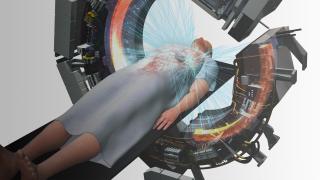City of Hope is among the first in the nation to adopt a new radiotherapy technology that is expected to one day change the way metastatic cancer patients are treated.
Most radiotherapy technology cannot see all tumors, which is why physicians aim destructive beams of therapy at only one or two tumors at a time. City of Hope’s newly purchased RefleXion X1 is the first-ever platform that will combine targeted radiation therapy with positron-emission tomography (PET) imaging — today’s best cancer staging and imaging technique. The hope is that the machine will one day enable doctors to deliver biology-guided radiotherapy (BgRT), a treatment where tumors are detected in real time and radiation beams are aimed at each tumor to destroy it, even if the disease is moving because the patient is breathing.
“If we think of cancer as enemy combatants hiding in the jungle at night, biology-guided radiotherapy is like a group of veteran snipers wearing thermal imaging goggles to see all opponents regardless of where they’re hiding or going,” said Jeffrey Wong, M.D., chair of the Department of Radiation Oncology at City of Hope. “These sharp shooters can then precisely target the enemy for a kill.”
More than half of the people with cancer receive some form of radiotherapy, which is increasingly used in combination with chemotherapy or immunotherapy to increase progression-free survival. Today’s radiotherapy systems must use bigger targets for radiation than is necessary due to uncertainty about the exact location of disease or to account for movement during treatment. The hope is that the currently experimental BgRT technique will spare healthy bystander cells thanks to more precise imaging and targeting.
City of Hope’s An Liu, Ph.D., director of the Division of Radiation Physics, and Wong have advised the scientific team at RefleXion for several years and have now signed a collaboration agreement with the company, meaning City of Hope is part of a team of physician-scientists who will offer novel clinical trials to test and perfect next-generation treatments that use RefleXion’s BgRT technology.*
The U.S. Food and Drug Administration has cleared the X1 machine for the delivery of stereotactic body radiotherapy, stereotactic radiosurgery and intensity modulated radiotherapy. It is expected to be ready for City of Hope’s patients in the first quarter of 2021. The initial clinical trials will test the safety and efficacy of BgRT on patients with metastatic cancers.
“The technology may one day allow us to provide therapy to more patients with metastatic disease,” Liu said.
In addition, City of Hope is developing new and more sensitive PET imaging tracers that identify disease targets by lighting up the imaging screen, including targeted PET tracers to detect cancers of the gastrointestinal tract, breast, lung, blood and bone marrow. City of Hope is also developing novel radioactive antibodies. The researchers hope to bring the world closer to the ability to deliver personalized radiotherapy — treatment specific to a specific cancer’s signature.
City of Hope has a track record of being an early adopter of leading-edge radiation technology that later becomes standard-of-care. City of Hope performed the world’s first total marrow irradiation procedure using TomoTherapy technology in 2005. It is now adopted worldwide. This technology uses computerized tomography scans to target tumors more precisely, improving treatment and reducing side effects. City of Hope also was the first in the U.S. to treat prostate cancer using focused ultrasound guided by real-time magnetic resonance imaging. This noninvasive technique is a radiation-free method and reduces the risk of complications.
“We are always on the lookout for ways to get the treatments of tomorrow to patients today,” Wong said.
# # #
*City of Hope is a minority investor in RefleXion, and currently holds less than 1% of the company’s outstanding shares.

